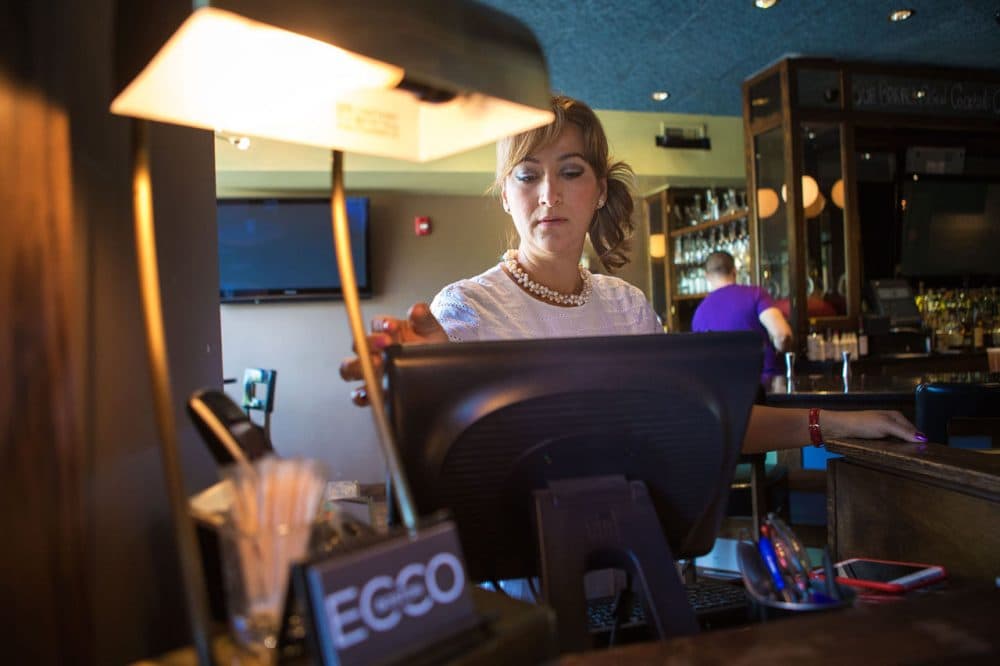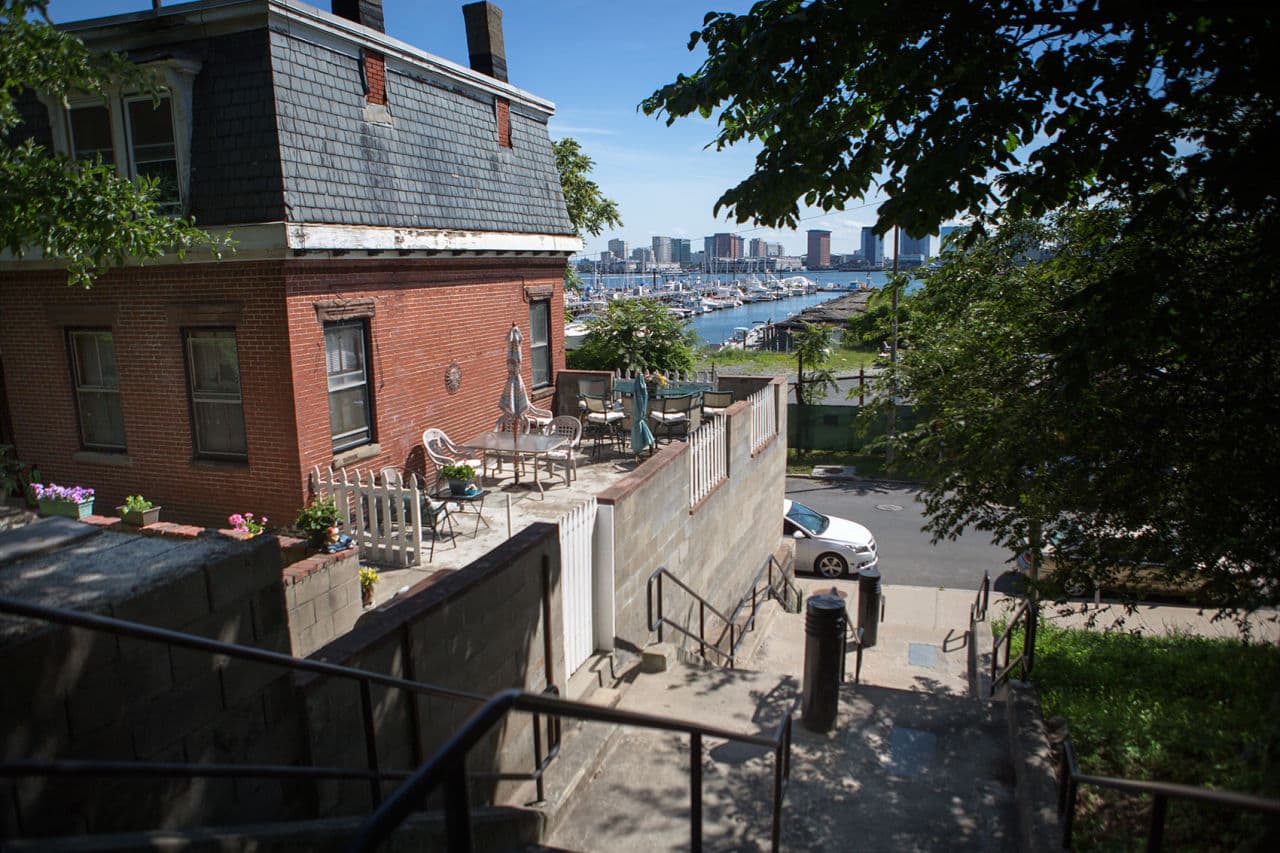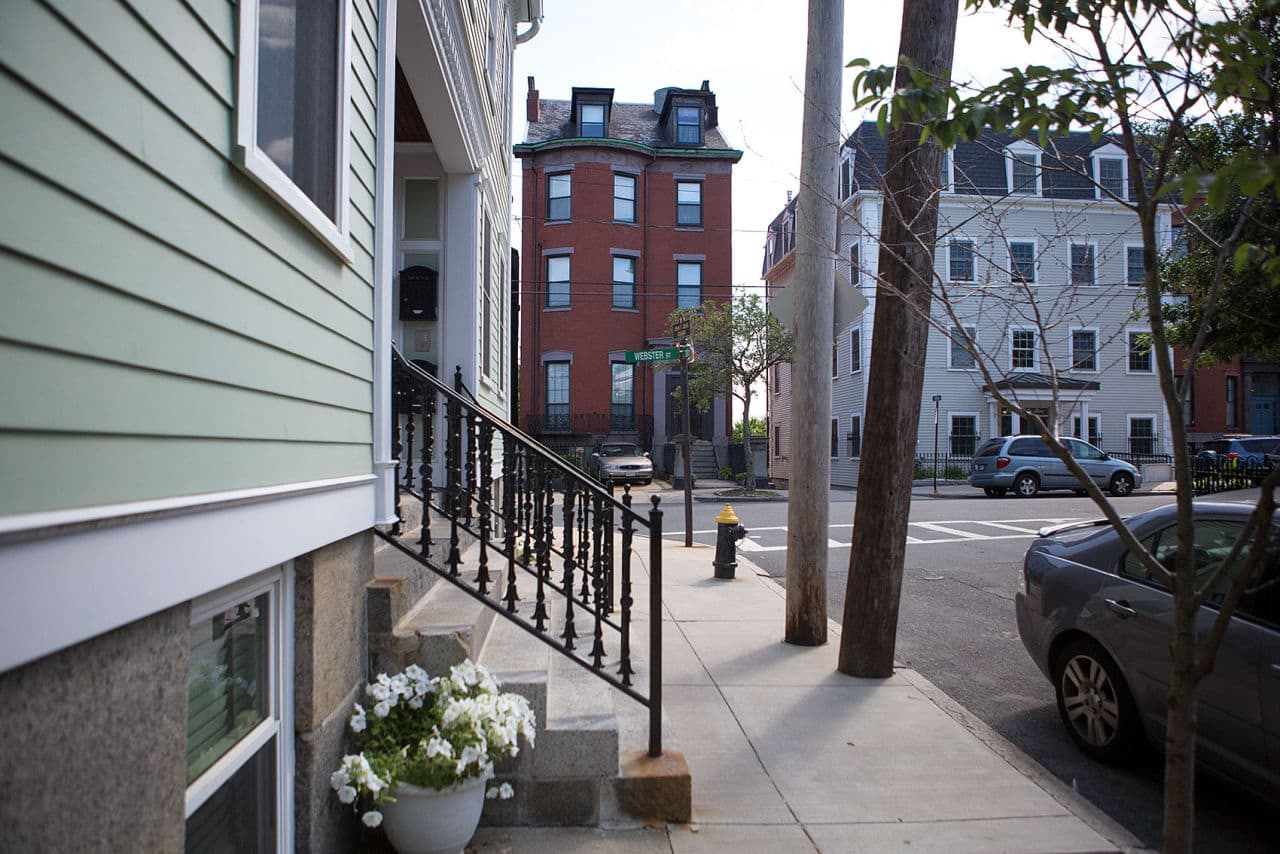Advertisement
'The First To Leave East Boston Are Us': Rising Rents Are Pushing Some Residents Out
Resume
In some ways the contrast between Santarpios and Ecco -- a gritty pizzeria that sells pies out the backdoor, and a swanky eatery with a gluten-free menu -- parallels the old East Boston and the new.
"People are renovating, a lot of construction companies are developing the city, the new face of East Boston," said Diana Morell, a manager at Ecco, which was actually founded by the owners of Santarpios. "I am afraid that the character of East Boston is going to be lost.”
The development “is great,” Morell added. “But how about the ones who made East Boston? The ones that have been living here for the past 10, 15, 20 years, who were not fortunate enough to buy property here. Those are the ones who are getting pushed out.”
The neighborhood of Logan Airport still has Boston's highest concentration of foreign-born residents. But home values have more than quadrupled over the last two decades, Zillow records show, and skyrocketing rents are forcing people to move elsewhere.
"How about the ones who made East Boston? ... Those are the ones who are getting pushed out.”
Diana Morell
"The first to leave East Boston are us,” Keylin Chicas, 23, said in Spanish.
Chicas' mother left her in El Salvador when Chicas was a child, joining siblings who’d already settled in East Boston. Five years ago she came to live with her mom. But last year, when their landlord raised the rent from $1,150 to $1,700 they had to move out and try to find an affordable place.
"We decided to look outside of East Boston, in Chelsea, Revere," she said, referring to her mother and siblings. "There was nothing in East Boston, everything was too expensive. And these aren't even luxury apartments, they're not remodeled. And the landlords want to charge more."
Chicas, who's the current Miss El Salvador Massachusetts, says practically her entire family lives here. She has seven aunts and uncles in East Boston and more than a dozen cousins.
“The rest of the family is still living here. Some own homes, others are renting and their rents haven't gone up yet," she said. "But with time, if the situation continues as is, they're going to have to leave."
Unable to find a place in Eastie, they moved north to Revere. Chicas decided to keep looking for a place she could afford in the old neighborhood. But a few months into it she gave up her search.
'New Phase Of Speculators And Renovators'
Stories of exodus are increasingly common in East Boston, but it’s happening across the city. A recent study from Northeastern University suggests Boston's housing market is in crisis: Young millennials and aging baby boomers are relocating from the suburbs, occupying housing that traditionally went to blue-collar Bostonians.
Tony Giacalone, a real estate broker who's operated in East Boston for more than three decades, says he's spotted a trend.
"There's this new phase of speculators and renovators that have come in in the last year and a half, and maybe a few hundred units where they've gone in, and they've renovated and they're charging $2,500 and $3,000, where the families that are paying $1,200 or $1,300 either can't or wouldn't pay," Giacalone said.
One of the investors is 27-year-old Alex Hodara, a Boston University graduate and CEO of the Hodara Real Estate Group. He declined to go on tape for this story, but in 2011 he explained his beginnings to CNBC.
"Freshman year, I was sitting in my dorm, and I was looking around at everyone there, and I was like … how can I make the most money off everyone here?' " he said with a laugh. He got his real estate license at 18.
State land records show Hodara bullish on the neighborhood. He's listed as an agent of more than 40 LLCs associated with residential properties -- each one of them in East Boston. The purchases date back less than two years, and records show the total sale value as nearly $20 million.
Said Giacalone of Hodara: "His strategy is basically, ‘I've discovered a neighborhood close to downtown Boston, near the T, where properties are basically in disrepair, let me go in and make them nicer, and I've got a market that basically hasn't been tapped.’ "
In an email, Hodara said he buys, renovates and leases multi-family buildings “with the help of investors who see my vision.”
He estimates that over the last year and a half he bought 42 of 200 buildings sold in East Boston. Hodara says his rents are just above average, and that he's renovating buildings that were previously unlivable.
“I am contributing to average rents in East Boston,” he wrote. “Buildings contributing to higher rental amounts would be all the new construction going on in East Boston. Everyone, like me, who is taking housing that is broken down and fixing it is probably renting their property for the average amount. The buildings we buy are typically unsafe and unlivable.”

A New Generation Of Non-Immigrants
East Boston's status as an immigrant enclave goes back to the first generation of the Kennedy clan, Patrick Kennedy, who settled there in 1849. The Irish and Canadians were followed by waves of Italian and Jewish immigrants. (The Jewish Cemetery Association says that by 1913, East Boston had five synagogues.) And now it's Latinos, from countries including El Salvador and Colombia, who make up more than half of East Boston residents, according to 2013 U.S. Census estimates.
But some in the community fear East Boston’s immigrant character is beginning to change. The latest wave into Eastie are non-immigrants.
The neighborhood is ideal for those yearning for the urban lifestyle. It has relatively cheap housing, close proximity to downtown and the Blue Line, as well as offerings like ethnic restaurants, bakeries and barbershops.
"We're three blocks from the water, you can’t beat that," said Natalie Benson, a resident who teaches third grade at a neighborhood public school. "The food is wonderful, it's Italian and Latin food … I speak Spanish so you speak Spanish everywhere you go, which is great."
Benson moved to East Boston four years ago and lives with her partner, who works in the tech sector. On a sunny Saturday she sat on a dock in front of a new residential development -- Portside at East Pier -- where two-bedroom apartments start at $3,200. There’s a brilliant view of the Boston skyline; her boyfriend fiddled with a fishing rod.
Reminiscing on the family of her Italian grandparents who once lived in East Boston, Benson said it’s a close-knit, neighborly community. "People are so friendly, so willing to help, like if I have any problem with my car, anything in my neighborhood, I have 10 people coming to help me.”
Originally from Lexington, Benson moved to East Boston's fast-developing Jeffries Point section from Somerville, where she said the rents were getting too high. She likes the changing face of the neighborhood: a new yoga studio, healthy food options and the conversion of dumpy lots into shining waterfront developments.
But Benson laments that East Boston is losing something vital. She said it’s happening in her classroom.
"I don’t want my families to be driven out," she said, referring to her students. "I was in a meeting yesterday and one of my kids has to leave and he’s devastated. They’ve been here for a long time, but their building was sold, and they can’t afford the rent anymore."
Despite those leaving, some say East Boston is as Latino as it’s ever been.
Census numbers through 2013 show the percentage of Hispanic residents ticking up every year since the turn of the century. The latest estimates say 57 percent of East Bostonians are Latino.

'We’re Fighting Against Displacements'
The changes in East Boston are happening citywide, with even greater increases in property values in parts of Dorchester and Roxbury.
A 2013 study by the Federal Reserve Bank of Cleveland shows Boston leading the country in gentrification. The Cleveland Fed reported that 61 percent of areas that could gentrify did gentrify -- more than three times the rate of America’s 50 biggest cities.
East Boston resident Jose Maria España recently marched to protest evictions, in a march organized by the nonprofit City Life/Vida Urbana.
"We’re fighting against displacements, and so they fix our apartments and stop raising the rent," España said in Spanish.
España, a single father whose landlord hiked his rent by nearly 50 percent, said it’s clear the rents are changing the makeup of the community.
"At this rate, in four years there won't be any more Hispanics in East Boston," he said. "We'll all be expatriated because of these rents. If we don't stop this, we'll be earning only to pay the rent, only to benefit the investors."
For City Life/Vida Urbana housing activist Steve Meacham, some of what's happening today traces back to 1994, when voters across the state overturned rent control in Boston, Cambridge and Brookline. Short of calling for rent control, his organization is lobbying Boston city councilors to pursue a home rule petition that would protect tenants.
"People who are being evicted by banks post-foreclosure, that would be illegal," Meacham said. "People who are being evicted by flippers, just to clear out a building and then resell the building, that would be illegal. And then for people who are getting large rent increases they can't afford ... if it's a big landlord, they'd have to mediate one time with the tenant."
He said the measures would give some recourse to those getting pushed out of Boston. City Life also holds weekly tenant meetings in East Boston, protesting evictions and helping residents negotiate with landlords.
"It’s not magic,” he added. “It’s just the fact that once you decide to organize and fight back, you have a lot of leverage that you don’t have when you’re acting as an individual.”
Correction: An earlier version of this post misstated where Natalie Benson is from, and which family members of hers were from Eastie. We regret the error.
This article was originally published on July 06, 2015.
This segment aired on July 1, 2015.
